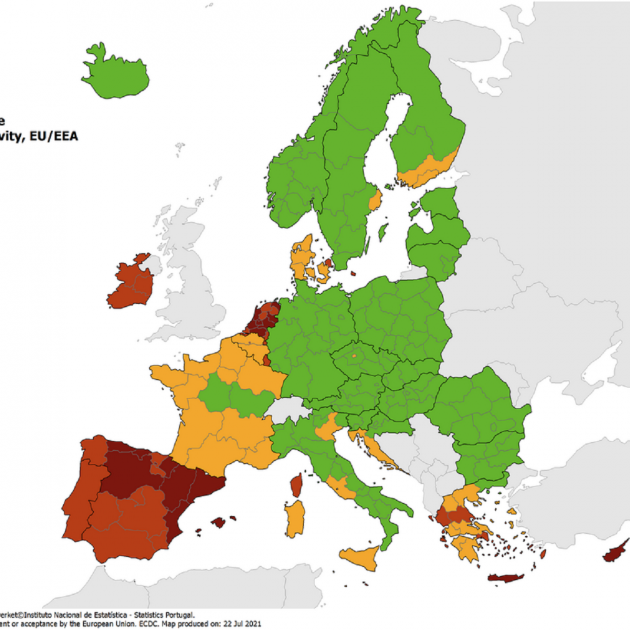The dark red smear is spreading across more and more of the Spanish state. The European Centre for Disease Prevention and Control's weekly map for the 27 EU countries as well as Iceland, Norway and Liechtenstein uses deep red for territories in situation of maximum Covid risk, that is, with 14-day cumulative incidence (IA14) of more than 500 cases per 100,000 inhabitants. Four new Spanish autonomous communities are in this situation as of today.
European Centre for Disease Prevention and Control's Map of IA14 for the week of July 22nd
Since the last map update, seven days ago, the Balearic Islands, the Valencian Country, Asturias and Cantabria have entered this dangerous situation. Catalonia, Castilla y León and Navarra have been classified as maximum risk areas for the last week.
50% of Europeans completely vaccinated
Spain, however, is not the only country on the map where the data is getting worse. Almost all of France, Luxembourg and some regions of Italy have gone from being low-risk areas to being considered medium-risk. Ireland and parts of Greece have become high risk and most of the Netherlands are at very high risk, the same category as the rest of the Iberian peninsula.
.
European Centre for Disease Prevention and Control's Map of IA14 for the week of July 15th
Meanwhile, the European Union as a whole has 53% of its adult population completely vaccinated. A first dose has been received by 67.4% of European adults. In total, 437,842,446 doses have been administered in the EU, with a total of 167,310,628 adults fully vaccinated. The countries with the lowest percentage of their populations' fully protected are Bulgaria (16.5%), Romania (30.1%) and Finland (34.6%), according to the ACN.
The study carried out by the German research centre Risklayer, using WHO data, includes additional countries, and as a consequence it portrays most of Eastern and Central Europe as an oasis of relatively low Covid rates, surrounded by countries where indicators are moderate or high - Russia and Turkey in the east, the Atlantic countries in the west, and in particular, the United Kingdom, which has several regions with incidence higher than that of the worst-hit Spanish communities.
Map prepared by the Risklayer centre, showing seven-day Covid incidence on July 22nd
Catalonia's contagion is beginning to stabilize
In fact, epidemiological indicators in Catalonia have been stabilizing for days, but it is the situation in hospitals that is now becoming critical, with a total of almost 2,000 people hospitalised with serious Covid-19. The number of people in intensive care has also risen to 440, 36 more than yesterday. According to data from the CatSalut authorities, 31% of those admitted to ordinary hospital wards for Covid are under the age of 40, when in previous waves they only occupied 10% of beds.
In this context, the Catalan High Court has, as expected, authorized the curfew in 165 municipalities in Catalonia to continue for another week, until July 30th. Government spokesperson Patrícia Plaja told a press conference on the situation of the pandemic that the Catalan executive intends to extend its other restrictions throughout the summer. That is:
- Everything closes at 12:30am.
- Groups of ten at the most.
- No eating or drinking in groups in the street.
- Audiences for cultural events have to be seated and spaced.
The official decree extending these regulations is still to be published, and at present they expire on July 23rd.
Main image, map of the European Centre for Disease Prevention and Control for the week of July 22
